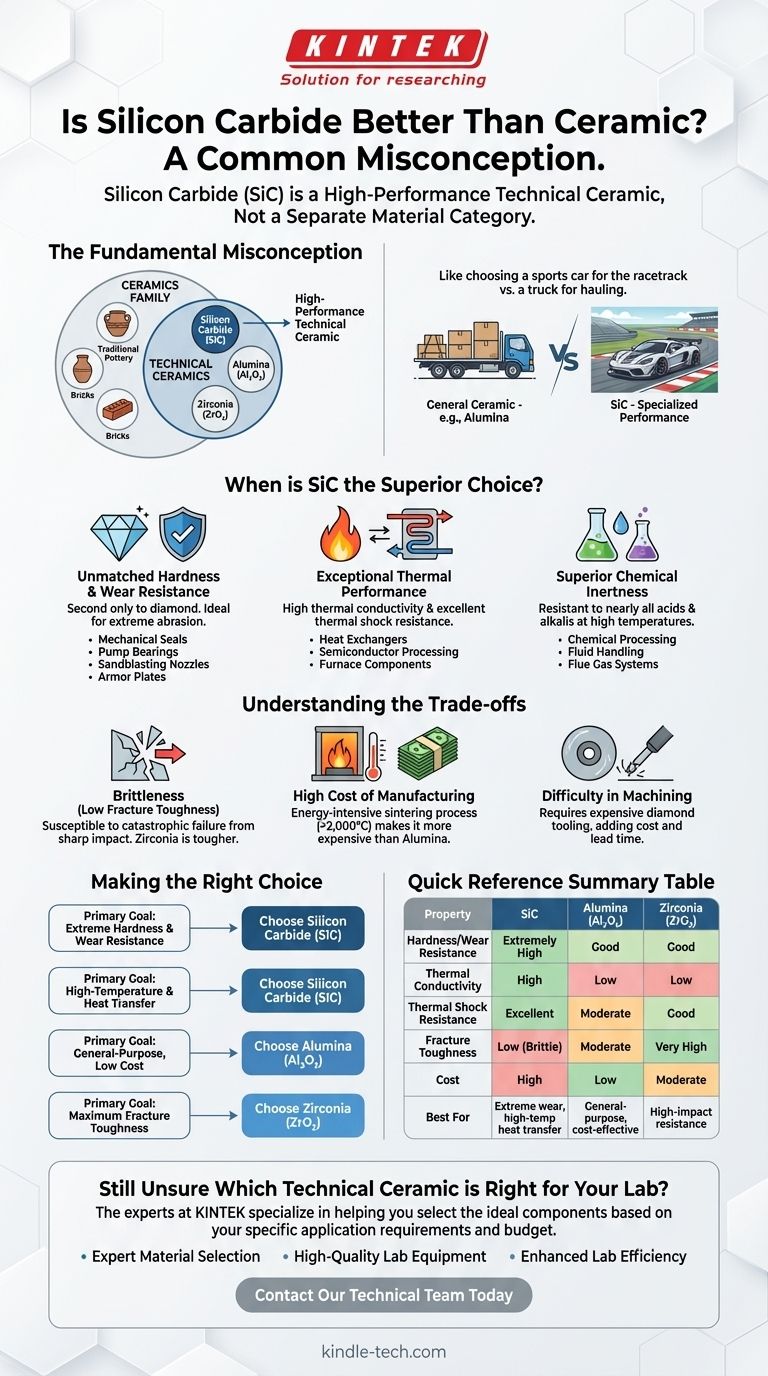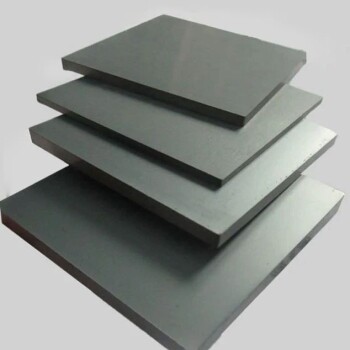La pregunta de si el carburo de silicio es "mejor" que la cerámica se basa en un malentendido común. El carburo de silicio (SiC) no es una categoría de material separada; es un miembro de alto rendimiento de la familia de las cerámicas técnicas. La verdadera pregunta es cómo se compara el SiC con otras cerámicas comunes, como la alúmina o la zirconia, y para qué aplicaciones específicas sus propiedades únicas lo convierten en la opción superior.
El término "cerámica" abarca una amplia gama de materiales. El carburo de silicio es una cerámica avanzada o técnica, apreciada por su dureza y conductividad térmica excepcionales, pero su alto coste y fragilidad significan que no es universalmente "mejor" que cerámicas más comunes como la alúmina para todas las tareas.

El concepto erróneo fundamental: El carburo de silicio es una cerámica
El concepto más crítico a comprender es que usted no está eligiendo entre carburo de silicio y cerámica, sino seleccionando un tipo específico de cerámica para un trabajo. Comparar el SiC con la "cerámica" es como preguntar si un coche deportivo es mejor que un "vehículo". Un coche deportivo es excelente para una pista de carreras, pero un camión es mejor para transportar carga.
¿Qué define a una "cerámica"?
Una cerámica es un sólido inorgánico no metálico preparado por la acción del calor y el enfriamiento posterior. Esta amplia categoría incluye todo, desde la alfarería tradicional y los ladrillos hasta los materiales avanzados de alta pureza diseñados para funciones técnicas específicas.
Dónde encaja el carburo de silicio
El carburo de silicio es una cerámica técnica, también conocida como cerámica avanzada o de ingeniería. Estos materiales se desarrollan para exhibir propiedades altamente especializadas. El SiC se compara a menudo con otras cerámicas técnicas como la alúmina (óxido de aluminio), un caballo de batalla versátil y rentable, y la zirconia, conocida por su excepcional tenacidad a la fractura.
¿Cuándo es el carburo de silicio la opción superior?
Las propiedades del carburo de silicio lo convierten en el candidato principal para algunas de las aplicaciones industriales y de alta tecnología más exigentes. Sobresale donde otros materiales, incluidas otras cerámicas, fallarían.
Dureza y resistencia al desgaste inigualables
El carburo de silicio es uno de los materiales comercialmente disponibles más duros, solo superado por el diamante. Esto le confiere una resistencia fenomenal a la abrasión, la erosión y el desgaste por deslizamiento.
Esta propiedad lo convierte en la opción ideal para componentes como sellos mecánicos, cojinetes de bombas, boquillas de chorro de arena y placas de blindaje balístico.
Rendimiento térmico excepcional
La mayoría de las cerámicas son aislantes térmicos, pero el SiC es una excepción notable con una alta conductividad térmica. Puede disipar el calor rápidamente mientras soporta temperaturas extremadamente altas sin degradarse.
Su baja expansión térmica y su alta resistencia también le confieren una excelente resistencia al choque térmico, lo que significa que puede soportar cambios rápidos de temperatura sin agrietarse. Esto es crucial para piezas en intercambiadores de calor, procesamiento de obleas de semiconductores y componentes de hornos.
Inercia química superior
El carburo de silicio demuestra una resistencia sobresaliente a casi todos los ácidos y álcalis, incluso a altas temperaturas. No se corroe ni se degrada en entornos químicos hostiles.
Esto lo hace inestimable para componentes utilizados en procesos químicos, manipulación de fluidos y sistemas de desulfuración de gases de combustión.
Comprender las compensaciones: Cuándo elegir otras cerámicas
A pesar de su rendimiento de élite, el SiC no siempre es la respuesta correcta. Su naturaleza especializada conlleva compensaciones significativas que hacen que otras cerámicas sean más adecuadas para diferentes aplicaciones.
El desafío de la fragilidad
Como la mayoría de los materiales extremadamente duros, el carburo de silicio es frágil. Tiene baja tenacidad a la fractura, lo que significa que puede ser susceptible a fallos catastróficos por un impacto brusco, mientras que una cerámica más resistente como la zirconia podría sobrevivir.
El alto coste de fabricación
Producir piezas de carburo de silicio densas y de alta pureza es un proceso intensivo en energía llamado sinterización, que requiere temperaturas (a menudo >2.000 °C) y presiones extremadamente altas.
Esto hace que los componentes de SiC sean significativamente más caros que los fabricados con una cerámica más común como la alúmina. Si la aplicación no exige las propiedades extremas del SiC, la alúmina suele ser la opción más económica.
Dificultad en el mecanizado
La misma dureza que hace que el SiC sea excelente para la resistencia al desgaste también lo hace increíblemente difícil y costoso de mecanizar en formas finales complejas. El rectificado y el acabado deben realizarse con herramientas de diamante, lo que añade un coste y un tiempo de entrega sustanciales a un proyecto.
Tomar la decisión correcta para su aplicación
Seleccionar la cerámica correcta requiere una comprensión clara de su objetivo de ingeniería principal y su presupuesto.
- Si su enfoque principal es la dureza extrema y la resistencia al desgaste: El carburo de silicio es casi con certeza la mejor cerámica técnica para el trabajo.
- Si su enfoque principal es el rendimiento a alta temperatura combinado con la transferencia de calor: La conductividad térmica única del carburo de silicio lo convierte en una opción superior a la mayoría de las demás cerámicas.
- Si su enfoque principal es el aislamiento eléctrico de uso general y una buena resistencia mecánica a bajo coste: La alúmina (óxido de aluminio) es el estándar de la industria y la opción más práctica.
- Si su enfoque principal es la máxima tenacidad a la fractura y la resistencia a las grietas: La zirconia es a menudo un mejor candidato que el carburo de silicio, más frágil.
Elegir el material adecuado es una cuestión de hacer coincidir las propiedades específicas con las demandas de su aplicación.
Tabla resumen:
| Propiedad | Carburo de silicio (SiC) | Alúmina (Al₂O₃) | Zirconia (ZrO₂) |
|---|---|---|---|
| Dureza / Resistencia al desgaste | Extremadamente alta | Buena | Buena |
| Conductividad térmica | Alta | Baja | Baja |
| Resistencia al choque térmico | Excelente | Moderada | Buena |
| Tenacidad a la fractura | Baja (Frágil) | Moderada | Muy alta |
| Coste | Alto | Bajo | Moderado |
| Mejor para | Desgaste extremo, transferencia de calor a alta temperatura | Aplicaciones de uso general y rentables | Resistencia a impactos altos |
¿Aún no está seguro de qué cerámica técnica es la adecuada para su laboratorio?
Elegir el material adecuado es fundamental para el rendimiento y la longevidad de su equipo de laboratorio. Los expertos de KINTEK se especializan en ayudar a laboratorios como el suyo a seleccionar los componentes ideales, desde elementos calefactores hasta crisoles y piezas de desgaste, basándose en los requisitos específicos de su aplicación y su presupuesto.
Ofrecemos:
- Selección experta de materiales: Reciba asesoramiento personalizado sobre si el carburo de silicio, la alúmina, la zirconia u otra cerámica avanzada es la opción óptima para su proceso.
- Equipos y consumibles de laboratorio de alta calidad: Adquiera componentes duraderos y fiables que garanticen que sus experimentos y procesos funcionen sin problemas.
- Eficiencia de laboratorio mejorada: El material adecuado minimiza el tiempo de inactividad, reduce los costes de reemplazo y mejora la precisión de sus resultados.
No permita que las limitaciones de los materiales frenen su investigación. Póngase en contacto con nuestro equipo técnico hoy mismo para una consulta y deje que KINTEK le proporcione la solución que necesita.
Guía Visual

Productos relacionados
- Lámina Cerámica de Carburo de Silicio (SiC) Resistente al Desgaste, Cerámica Avanzada Fina de Ingeniería
- Placa de cerámica de carburo de silicio (SiC) para ingeniería de cerámicas finas avanzadas
- Lámina de Cerámica de Nitruro de Silicio (SiN) Mecanizado de Precisión para Ingeniería de Cerámicas Finas Avanzadas
- Junta aislante de cerámica de zirconio Ingeniería avanzada de cerámica fina
- Elementos Calefactores de Carburo de Silicio SiC para Horno Eléctrico
La gente también pregunta
- ¿Cuál es la expansión térmica del SiC? Domina su bajo CTE para un rendimiento superior a altas temperaturas
- ¿Cuál es más duro, el carburo de silicio o el carburo de tungsteno? Descubra la clave para la selección de materiales
- ¿Cuáles son las características del SiC? Desbloqueando el rendimiento de alta temperatura, dureza e inercia química
- ¿Cuáles son las propiedades del SiC? Desbloquee el rendimiento a alta temperatura y alta frecuencia
- ¿El carburo de silicio es resistente al calor? Desbloquee un rendimiento superior en temperaturas extremas



















